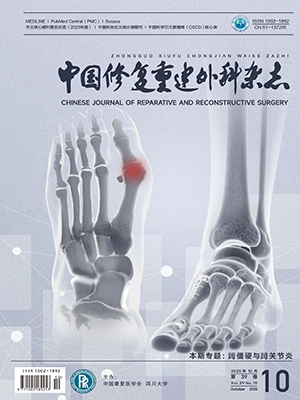Objective To analyze the effectiveness of single three-dimensional (3D)-printed microporous titanium prostheses and flap combined prostheses implantation in the treatment of large segmental infectious bone defects in limbs. Methods A retrospective analysis was conducted on the clinical data of 76 patients with large segmental infectious bone defects in limbs who were treated between January 2019 and February 2024 and met the selection criteria. Among them, 51 were male and 25 were female, with an age of (47.7±9.4) years. Of the 76 patients, 51 had no soft tissue defects (single prostheses group), while 25 had associated soft tissue defects (flap combined group). The single prostheses group included 28 cases of tibial bone defects, 11 cases of femoral defects, 5 cases of humeral defects, 4 cases of radial bone defects, and 3 cases of metacarpal, or carpal bone defects, with bone defect length ranging from 3.5 to 28.0 cm. The flap combined group included 3 cases of extensive dorsum of foot soft tissue defects combined with large segmental metatarsal bone defects, 19 cases of lower leg soft tissue defects combined with large segmental tibial bone defects, and 3 cases of hand and forearm soft tissue defects combined with metacarpal, carpal, or radial bone defects, with bone defect length ranging from 3.8 to 32.0 cm and soft tissue defect areas ranging from 8 cm×5 cm to 33 cm×10 cm. In the first stage, vancomycin-loaded bone cement was used to control infection, and flap repair was performed in the flap combined group. In the second stage, 3D-printed microporous titanium prostheses were implanted. Postoperative assessments were performed to evaluate infection control and bone integration, and pain release was evaluated using the visual analogue scale (VAS) score. Results All patients were followed up postoperatively, with an average follow-up time of (35.2±13.4) months. In the 61 lower limb injury patients, the time of standing, walk with crutches, and fully bear weight were (2.2±0.6), (3.9±1.1), and (5.4±1.1) months, respectively. The VAS score at 1 year postoperatively was significantly lower than preoperative one (t=−10.678, P<0.001). At 1 year postoperatively, 69 patients (90.8%) showed no complication such as infection, fracture, prosthesis displacement, or breakage, and X-ray films indicated good integration at the prosthesis-bone interface. According to the Paley scoring system for the healing of infectious bone defects, the results were excellent in 37 cases, good in 29 cases, fair in 3 cases, and poor in 7 cases. In the single prostheses group, during the follow-up, there was 1 case each of femoral prostheses fracture, femoral infection, and tibial infection, with a treatment success rate of 94.1% (48/51). In lower limb injury patients, the time of fully bear weight was (5.0±1.0) months. In the flap combined group, during the follow-up, 1 case of tibial fixation prostheses screw fracture occurred, along with 2 cases of recurrent foot infection in diabetic patients and 1 case of tibial infection. The treatment success rate was 84.0% (21/25). The time of fully bear weight in lower limb injury patients was (5.8±1.2) months. The overall infection eradication rate for all patients was 93.4% (71/76). Conclusion The use of 3D-printed microporous titanium prostheses, either alone or in combination with flaps, for the treatment of large segmental infectious bone defects in the limbs results in good effectiveness with a low incidence of complications. It is a feasible strategy for the reconstruction of infectious bone defects.
Citation:
XU Yongqing, FAN Xinyu, WANG Teng, PU Shaoquan, CAI Xingbo, SHI Xiangwen, LIN Wei, YANG Xi, LI Jian, LIU Min. Effectiveness of three-dimensional-printed microporous titanium prostheses combined with flap implantation in treatment of large segmental infectious bone defects in limbs. Chinese Journal of Reparative and Reconstructive Surgery, 2025, 39(5): 521-528. doi: 10.7507/1002-1892.202502045
Copy
Copyright © the editorial department of Chinese Journal of Reparative and Reconstructive Surgery of West China Medical Publisher. All rights reserved




